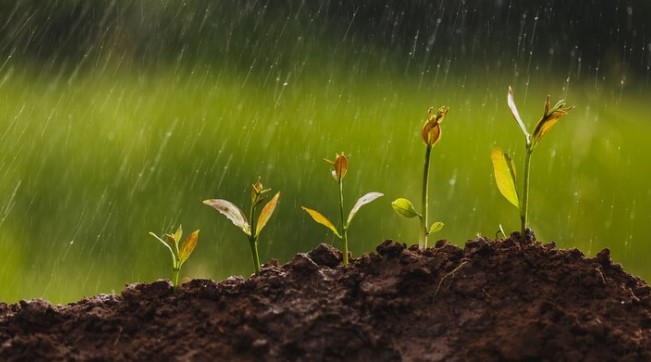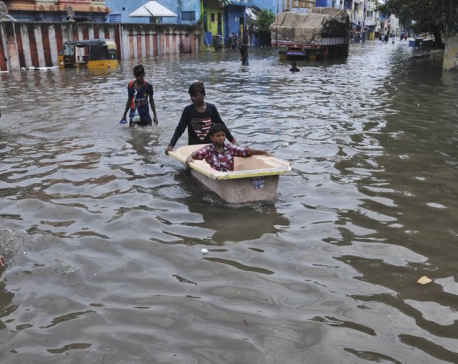
OR
Early monsoon expected to bring relief from sweltering heat across Nepal
Published On: June 10, 2024 09:20 PM NPT By: Sara Pahari

The monsoon has arrived in Nepal three days earlier than scheduled this year
KATHMANDU, June 10: The monsoon has made an early entrance into Nepal, marking the onset of the rainy season. The Weather Forecasting Division of the Department of Hydrology and Meteorology announced that the monsoon commenced in Nepal’s Koshi province, three days ahead of the usual date of June 13.
While the entire Koshi region is not yet full under the influence of monsoon, this gradual progression is typical as the system advances from the east.
This early arrival, while a relief to the farmers, brings both excitement and concern as everyone braces for its impact. According to forecasts made by the division, the monsoon season this year is expected to bring 35 to 55 percent more rainfall than the average.
The journey of the monsoon
The monsoon’s journey to Nepal shows how connected global weather systems are. Starting from the warm waters off the coast of Somalia, the monsoon winds travel across the Indian Ocean to Kerala, India. From there, the system splits; one path travels up the Arabian Sea, watering western India and Pakistan, while the other moves through the Bay of Bengal, impacting Myanmar, Bangladesh, Bhutan, and eventually Nepal. This journey, spanning thousands of kilometers, shows the vast and complex nature of the monsoon system.
According to the Department of Hydrology and Meteorology, the monsoon’s advance is a complex interplay of jet streams and low-pressure systems, particularly influenced by conditions over the Tibetan Plateau and the western winds. The interaction of these systems creates the conditions necessary for the monsoon to progress into Nepal.
Implications for agriculture and economy
In Nepal, the monsoon is not just a weather phenomenon but a crucial factor for the economy. With agriculture contributing about 24% to the nation’s GDP, timely and adequate monsoon rains are vital for crop productivity and food security. An early monsoon can lead to better crop yields, thereby boosting the economy.
Nepali farmers, who rely heavily on monsoon rains for their crops, view this early onset with optimism. Rice, the staple crop, along with maize, millet, and other seasonal vegetables, depends on the monsoon. An early and robust monsoon can significantly enhance agricultural output, ensuring food security and stabilizing market prices. This, in turn, has a ripple effect on the economy, as increased agricultural productivity boosts overall economic growth.
Beyond agriculture, it affects water resources, hydropower generation, and overall economic stability. Nepal’s hydropower projects, such as Kulekhani, rely on monsoon rains to fill the reservoirs. Adequate rainfall ensures sufficient water flow for electricity generation, which is critical for both domestic consumption and export.
Additionally, the monsoon influences groundwater recharge, crucial for drinking water supplies and irrigation. In urban areas, water management systems depend on monsoon rains to replenish reservoirs and maintain water supply throughout the year.
However, excessive rainfall can lead to flooding and landslides, posing risks to lives and infrastructure. The National Disaster Risk Reduction and Management Authority (NDRRMA) estimates that around 1.8 million people could be affected by monsoon-related disasters this year. With the forecast indicating above-average rainfall, preparedness is more critical than ever.
Disaster preparedness and risks
While the monsoon brings much-needed water for agriculture, it also brings challenges in the form of natural disasters. Flooding and landslides are common during this season, particularly in the hilly and mountainous regions of Nepal. The government, in coordination with various agencies, has been working on disaster preparedness plans to mitigate the impacts of these potential hazards.
The NDRRMA has already initiated several measures to ensure that vulnerable communities are prepared. These include early warning systems, community training programs, and the strategic placement of relief materials. Despite these efforts, the unpredictable nature of the monsoon means that vigilance and quick response mechanisms are essential.
The NDRRMA estimates that this year’s monsoon could impact approximately 400,000 households, with 1.8 million citizens potentially facing disruptions due to floods and landslides. As such, the authorities are urging communities to stay informed and heed warnings issued by meteorological and disaster management agencies.
The science behind the monsoon
The process is influenced by broader climate phenomena such as La Niña and El Niño, which affect sea surface temperatures and global weather patterns. These phenomena can either enhance or inhibit the monsoon, influencing its timing, intensity, and duration.
The monsoon winds are driven by the differential heating of the land and sea. During summer, the land heats up faster than the ocean, creating a low-pressure area over the Indian subcontinent. This draws in moist air from the ocean, resulting in widespread rainfall. The Tibetan Plateau also plays a crucial role by heating up and creating a low-pressure zone that pulls the monsoon winds northwards.
Historical context and patterns
Historically, the monsoon arrives in Nepal around June 13. However, variations are common, with early or late arrivals influenced by a range of atmospheric conditions. Data from the past thirty years shows that the monsoon typically lasts from June to September, bringing significant rainfall during this period.
Last year, Nepal recorded 1,303 mm of rainfall during the monsoon period, slightly below the average of 1,472 mm. This year, forecasts suggest a more robust monsoon, with higher than average rainfall expected. This prediction is based on current atmospheric patterns and the behavior of global climate phenomena.
Looking ahead
As the monsoon continues its westward journey, regions like Kathmandu and the western Terai will need to brace for its impact. While the monsoon brings relief from the heat and supports agricultural activities, the associated risks call for vigilant disaster management strategies.
The early arrival of the monsoon is a reminder of nature’s unpredictability and the need for preparedness. As Nepal welcomes the rains, the focus will be on harnessing their benefits while mitigating potential hazards. As the monsoon progresses, staying informed and prepared will be key to maximizing its benefits and minimizing its risks.
You May Like This

‘Priya Sufi’: a motivational story about sisters
KATHMANDU, Sept 23: After the success of love trilogy 'Summer Love', 'Saaya', and 'Monsoon', Subin Bhattarai is back with his... Read More...

Monsoon rains kill 12 in southern India, displace thousands
NEW DELHI, Nov 4 : Thousands of people took refuge in relief camps as torrential monsoon rains flooded parts of southern... Read More...

Monsoon to begin after a week
KATHMANDU, June 11: The monsoon is delayed this year, too. Normally, the monsoon begins from June 10 in our country... Read More...






Just In
- NRB introduces cautiously flexible measures to address ongoing slowdown in various economic sectors
- Forced Covid-19 cremations: is it too late for redemption?
- NRB to provide collateral-free loans to foreign employment seekers
- NEB to publish Grade 12 results next week
- Body handover begins; Relatives remain dissatisfied with insurance, compensation amount
- NC defers its plan to join Koshi govt
- NRB to review microfinance loan interest rate
- 134 dead in floods and landslides since onset of monsoon this year











Leave A Comment